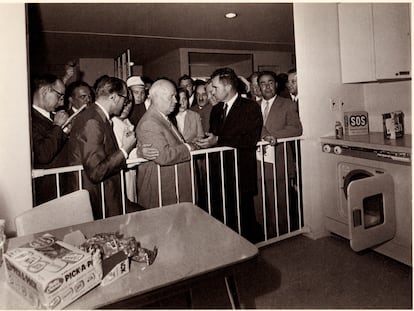Lessons from a Cold War bunker to survive the end of the world
Geopolitical uncertainty and Putin’s threats have triggered more frequent visits to the Diefenbunker in Ottawa, Canada – one of the largest decommissioned nuclear shelters on the planet. Meanwhile, the success of ‘The Last of Us’ has proven our cultural fascination with the apocalypse
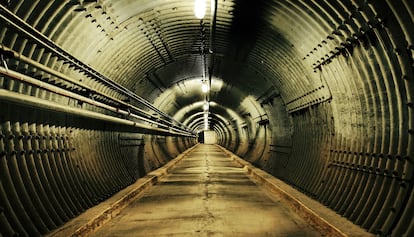
In a rural area not far from Ottawa, a time warp lurks among the fields, covered in late-winter snow.
During the toughest years of the Cold War, Canadian Prime Minister John Diefenbaker – who governed from 1957 until 1963 – ordered the construction of one of the world’s largest bunkers. It would be for members of his cabinet and a handful of between 500 and 600 chosen ones, so that they could be safe in the event of a nuclear attack. It would be necessary to guarantee the continuity of the government and the reconstruction of the country after the bomb.
The capital of the North American country – where the 1945 defection of Igor Gouzenko from the Soviet Union marked the new division of global political blocs – was a target in and of itself. Above all, however, Canada was simply in the trajectory of Soviet nuclear fury, if Moscow ever decided to nuke the United States by way of the Arctic.
The 107,000-square-foot underground complex – spread over four floors, excavated up to 100 feet deep – never had to be used. It was baptized as the “Diefenbunker” in 1961, when a Toronto journalist revealed what was truly behind the construction of what was supposedly a military communications center. The reporter had been taken aback by how many earthquake-proof toilets were being hauled by truck to the outskirts of Ottawa. So, he chartered a plane… and ended up cracking the case.
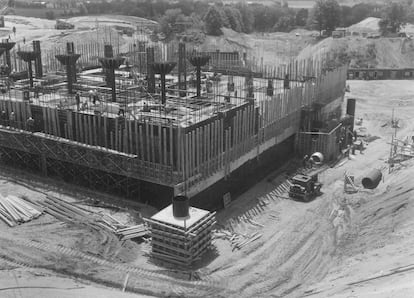
In 1994 – its raison d’être having disappeared with the fall of the Berlin Wall – the Canadian Armed Forces demilitarized the facility. Four years later, it reopened as a Cold War museum.
The Diefenbunker is one of the best-preserved bunkers among those accessible to the public in the world. “It also functions in the evenings as the world’s largest escape room,” Christine McGuire – its executive director – proudly notes, describing one of the museum’s most popular activities.
It receives about 45,000 visitors annually – a figure that continues to rise. The war in Ukraine, Putin’s threat to use his nuclear arsenal, as well as rising tensions between China and the United States have not only brought the Bulletin of Atomic Scientists’ symbolic “doomsday clock” closer than ever to the apocalypse. These events have also increased interest in the Diefenbunker.
“All of this,” says McGuire, sitting in one of the complex’s 358 rooms, “is a testament to how close we came as a species to annihilation. Fear and anxiety have returned to the fore. Many people ask us if [the Diefenbunker] could still serve as a shelter from radioactive fallout. We are sorry to have to say ‘no.’”
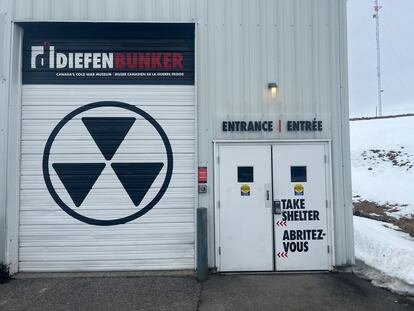
The visitors enter through the same two doors of the apocalypse that would only have been opened – if necessary – to the chosen ones: a group headed by the prime minister… and not his wife, Olivia, which, it was rumored at the time, angered Diefenbaker. He would be accompanied by the Governor General of Canada, between 10 and 12 members of the cabinet and the high command of the Canadian Armed Forces.
The first step would have been to shower twice – with hot and cold water – and go through the Geiger counter, to prove that they were free of radioactivity.
“Those who didn’t [would have been] sent to the medical center, which had capacity for everything – except for neurosurgery and open heart surgery,” explains Martha Boyd, the head of operations, as she guides EL PAÍS through the labyrinth of rooms. Furniture from the era is on display, strapped down to withstand “an explosion of up to five megatons 1.2 miles away.” The recreation of the oppressive environment leaves the visitor with a mixture of surrealness and claustrophobia.
Survival for 30 days
The bunker had everything to guarantee survival for 30 days… long enough for the radiation to dissipate outside. There were secure phone booths to communicate with the outside world, detention cells, offices for officials, spartan separate bedrooms for men and women, a large dining room with a relaxing images of the picturesque Bow River Valley and an isolated vault for storing the Bank of Canada’s gold reserves… on the other side of a 33-ton door. The opening instructions were only shared between four people.
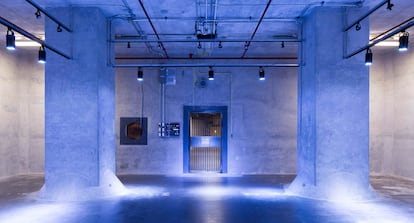
In the “war cabinet room” – designed for meetings convened by the surviving government – six different time zones are displayed by the clocks. There’s also a telephone that used to have a direct line to President Kennedy. In the studio reserved for Canada’s public radio – the CBC – a disturbing emergency message sounds, in which a voice from another time warns that “an attack on North America has been detected.”
Boyd explains that, from the moment the alarms sounded from the Distant Early Warning Line (DEW) system’s radar – located in the remote Canadian north – the count began. There were “between eight and 16 hours(...) to organize the evacuation.”
Despite such ominous messages, the head of operations clarifies that the idea “is not meant to scare [visitors].”
“On the contrary, we want to celebrate the success story that made us preserve peace for decades,” she says.
The prepared ones
Cultural geographer Bradley Garrett is the author of Bunker: Building for the End Times (2020). The book is about his fascinating journey around the world in search of “preppers” – tribes of libertarians. He’s dedicated a good part of his career to studying the sources of the fear that drives “builders for the end of time.”
Since the book came out, the world hasn’t stopped giving new reasons for paranoia – there are pandemics, spy balloons, global warming risks, nuclear threats, rumblings of civil war…
“Those who visit the bunker in Canada are like tourists from Chernobyl – one of the few places where the apocalypse has already materialized. They like to imagine themselves as survivors – to believe that, when the time comes, they’ll know how to get ahead,” Garrett explains by phone from California.
He thinks that these feelings are part of the success of the series (and video game) The Last of Us, in which a pandemic caused by a fungus wipes out most of the world’s population. One of the most interesting subplots is carried out by one of the survivalists – a figure similar to the ones who populate Garrett’s book.
The author links the healthiness of the prepper obsession in North America with the fact that the authorities – unlike the European countries on both sides of the Iron Curtain – never aspired to protect the entire population via the construction of bunkers during the Cold War.
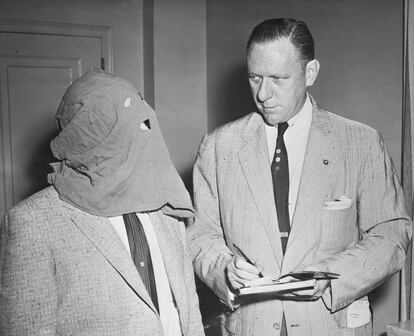
“[US President] Eisenhower was presented with a plan that budgeted for the creation of community shelters for the entire population at $300 billion – more than a year of the GDP [in the 1950s]. Obviously, the idea was scrapped. Instead, a program was created to encourage citizens to build their own homemade shelters. This made many people feel abandoned to their fate. What they didn’t know then is that, at the same time, the government was secretly planning bunkers to save themselves,” says Garrett.
“When the existence of some of these places was revealed in the 1990s, conspiracy theories broke out, along with the anti-government sentiment of these libertarian groups. The prepper movement has been in good health ever since.”
In Canada, things weren’t so different. The construction of 30 regional bunkers was planned, but only a dozen were completed. Of these, the Diefenbunker is the largest. Andrew Burtch – the historian in charge of the post-1945 collections at the War Museum in downtown Ottawa – is the author of a book on “the failure of Cold War civil defense in Canada.” Via videoconference, he explains that the weight of the contingency plans fell on an army of “volunteers” who organized “at a local level.”
“The Government delegated protection against a nuclear attack [to citizens]. Many people were frustrated. The idea that everyone had to build their own refuge contributed to this failure of civil defense,” the historian notes.
He adds that Canadian anxiety stemmed, above all, from its proximity to its neighbor to the South.
“The planners considered that the greatest risk could come from Soviet planes [being] shot down by NORAD (North American Aerospace Defense Command) or from the indirect radiation that fell from the overflight of the bombers… even if they didn’t release their projectiles on Canadian territory, but in places close to the border, such as Detroit. They couldn’t rule out the possibility of direct attacks, but these were highly unlikely.”
The writer Margaret Atwood – who was born in Ottawa at the beginning of the Cold War – recalled in a recent conversation with EL PAÍS that, in those days, Canadians had to get used to terms such as “acceptable mega-deaths.”
“The moment of greatest tension was undoubtedly the Cuban missile crisis,” said the author of The Handmaid’s Tale, who was taken by surprise in those autumn days of 1962, in Boston, where “things got very ugly.”
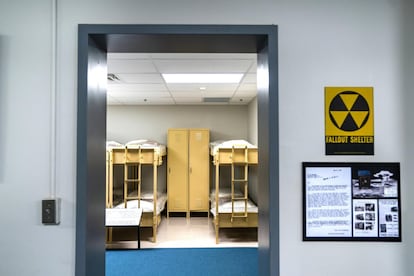
That was also a busy time in the Diefenbunker. After that peak of tension, life underground from the 1970s onwards became quite similar to that of a military base. There were occasional drills, in which soldiers spent several days inside to test the usefulness of the facilities.
Barry Bruce – who, at the time, was a family doctor in the nearby town of Carp – recalls in a telephone interview that the neighbors lived “without much tension” in the proximity of the shelter. Its existence was never a secret, unlike other bunkers, such as the Greenbrier, buried by the US government under a sumptuous hotel in West Virginia (it also allows visitors, but no picture-taking). It was discovered by a reporter for The Washington Post in 1992.
In 1980, Bruce received a call from the Diefenbunker’s commanding officer to recruit him as an emergency medical standby. Once the bunker was demilitarized, he led the crusade to prevent it from being paved over so that houses could be built over it. He and his fellow activists launched several campaigns to raise money via the first rounds of visits. Eventually, the museum project was proposed to the city council, which approved it “in a very close vote… three to two.”
“Eventually, they sold us the place for three bucks,” Bruce adds. “I think we made a good deal.”
Although the material is still classified, it’s estimated that the construction of the Diefenbunker cost $20 million dollars. Updated with inflation, that’s just over $200 million.
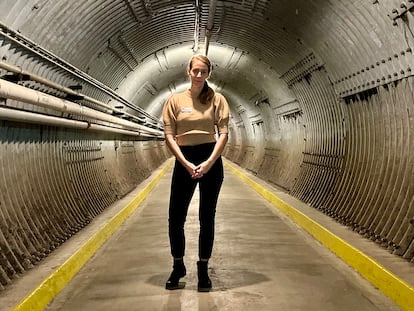
Today, the Diefenbubnker is administered as a foundation. According to its director, 75% of the income comes from visitors. Its mission is “to contribute to the critical understanding of the Cold War in Canada and the rest of the world.” A quarter-of-a-century after starting out as a museum, that mission has acquired a new meaning in times of geopolitical upheaval.
Sign up for our weekly newsletter to get more English-language news coverage from EL PAÍS USA Edition
Tu suscripción se está usando en otro dispositivo
¿Quieres añadir otro usuario a tu suscripción?
Si continúas leyendo en este dispositivo, no se podrá leer en el otro.
FlechaTu suscripción se está usando en otro dispositivo y solo puedes acceder a EL PAÍS desde un dispositivo a la vez.
Si quieres compartir tu cuenta, cambia tu suscripción a la modalidad Premium, así podrás añadir otro usuario. Cada uno accederá con su propia cuenta de email, lo que os permitirá personalizar vuestra experiencia en EL PAÍS.
¿Tienes una suscripción de empresa? Accede aquí para contratar más cuentas.
En el caso de no saber quién está usando tu cuenta, te recomendamos cambiar tu contraseña aquí.
Si decides continuar compartiendo tu cuenta, este mensaje se mostrará en tu dispositivo y en el de la otra persona que está usando tu cuenta de forma indefinida, afectando a tu experiencia de lectura. Puedes consultar aquí los términos y condiciones de la suscripción digital.
More information
Archived In
Últimas noticias
The story of the Málaga virus: The code that haunted Google’s cybersecurity center director for 30 years
The impact of Ecuador’s mega-prison: A polluted river, cleared forests and military checkpoints
Corinne Low: ‘I’m more concerned about the female happiness gap than the gender wage gap’
Trump traveled on Epstein’s plane ‘many more times’ than previously thought, according to new documents
Most viewed
- The low-cost creative revolution: How technology is making art accessible to everyone
- Christian Louboutin: ‘Young people don’t want to be like their parents. And if their parents wear sneakers, they’re going to look for something else’
- All the effects of gentrification in one corner of Mexico’s Colonia Roma
- Liset Menéndez de la Prida, neuroscientist: ‘It’s not normal to constantly seek pleasure; it’s important to be bored, to be calm’
- Christmas loses its festive spirit: ICE fears cast shadow over religious celebrations


